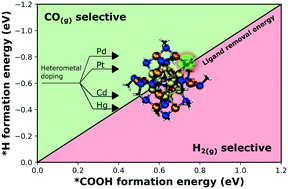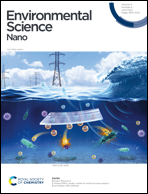Ligand removal energetics control CO2 electroreduction selectivity on atomically precise, ligated alloy nanoclusters†
Abstract
Atomically precise, thiolate-protected gold nanoclusters (TPNCs) exhibit remarkable catalytic performance for the electrochemical reduction of carbon dioxide (CO2R) to CO. The origin of their high CO2R activity and selectivity has been attributed to partial ligand removal from the thiolate-covered surfaces of TPNCs to expose catalytically active sulfur atoms. Recently, heterometal doped (alloy) TPNCs have been shown to exhibit enhanced CO2R activity and selectivity compared to their monometallic counterparts. However, systematic studies on the effect of doping (metal type and location on TPNC) on active site exposure and CO2R activity are missing in literature. Herein, we apply Density Functional Theory calculations to investigate the effect of heterometal (Pt, Pd, Hg and Cd) doping of Au25(SR)18 TPNC on the active site exposure and CO2R activity and selectivity. We reveal that doping significantly modifies relevant TPNC electronic properties, such as electron affinity, while also altering partial ligand removal and carboxyl (*COOH) intermediate formation energies. Furthermore, we demonstrate that changing the dopant (e.g. Hg) position can change the selectivity of the TPNC towards CO(g) or H2(g) formation, highlighting the importance of dopant locations in TPNC-based CO2R. Most notably, we report a universal (i.e. capturing different dopant types and positions) linear trend between the ligand removal energy and i) the *COOH formation energy, as well as, ii) the hydrogen (*H) formation energy on the different alloy TPNCs. Thus, utilizing the ligand removal energy as a descriptor for CO2RR activity and selectivity, our work opens new avenues for accelerated computational screening of different alloy TPNCs for electrocatalytic CO2R applications.



 Please wait while we load your content...
Please wait while we load your content...
